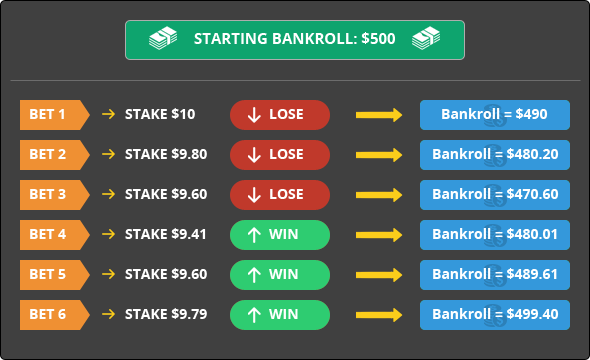What are Staking Plans?

To be a successful sports bettor you obviously have to be smart when deciding what to bet on. Making money from sports betting is not just as simple as being able to pick winners though. Anyone could pick a reasonably high percentage of winners if they were very selective and just backed strong favorites. This wouldn't necessarily be a profitable approach though, because the odds on strong favorites are always going to be very low. Low odds contribute to low payouts, and therefore just a few losses could easily wipe out the profits from many winning wagers.
That's why it's important to make your selections based on value. We explain why this is in our article on probability and value in sports betting. Briefly, though, the theory is that you should only ever bet when you feel that you have an edge over the bookmaker. To put it another way, you should only bet when the odds are higher than the actual probability of a wager winning.
Even finding value isn't enough by itself however. How much you stake is just as important. In fact, there are many profitable bettors that claim how much you stake is actually MORE important than what you bet on. That's debatable in our opinion, but it's certainly not a ridiculous claim. Either way, it's absolutely right to say that you're unlikely to make money if you don't put some serious thought into how much you stake and when. This is where staking plans come in.
In this article we explain all about staking plans. We explain what they are, and why you should use one. We also provide some examples of different plans.
Staking Plans: The Basics
The fundamental concept of staking plans is very straightforward. A staking plan is essentially a method for determining how much you should stake on any given wager. There are many different types of plans, but they all follow the same basic concept. They consist of a set of clearly defined rules, and those rules dictate exactly what your stake should be for every wager that you place.
There are several reasons why it's a good idea to use a staking plan. The primary reason is that it's a good tool for managing your bankroll. By having clear rules for how much to stake, it becomes easier to avoid carelessly wasting your money and going broke. Of course, this does depend on having the discipline to stick to the rules.
A staking plan also helps you to manage risk. It's possible to choose an aggressive plan that's high risk but offers the potential for high rewards, while it's also possible to choose a safer plan that has less risk but will cause your bankroll to grow at a slower rate. Your decision should be based on your attitude toward risk and your betting goals.
We've already mentioned how there are different types of staking plans, and you can even devise your own. All plans can be broadly divided into two categories though.
We'll explain each of these categories below. We also demonstrate some example plans to illustrate how they work in practice.
Fixed Staking Plans: Definition & Examples
A fixed staking plan is exactly what the name suggests. It's a plan that involves using a fixed stake for each and every bet. Fixed staking plans are the most straightforward of the two main types, and they're popular for that very reason. However, many bettors feel that they are TOO simplistic and have limited use.
We believe that fixed staking plans are worth considering. They're probably not ideal for advanced bettors who are already making consistent profits, but they're good for recreational bettors and those just starting to take their betting seriously.
We'll now look at two examples of fixed staking plans.
Level staking is the simplest of all plans. All you do is stake exactly the same amount for each and every wager. The hard part is determining how much you want that to be. There are no set rules for this decision, but it's advisable to keep it below 5% of your starting bankroll. Around 1-2% is best in our opinion. So if your starting bankroll is $500, you should fix your stake at somewhere between $5 and $10. The absolute maximum should be $25.
Percentage staking is only marginally more complicated than level staking. It involves staking a percentage of your bankroll on each wager. The percentage itself is fixed, but the amount staked will fluctuate as your bankroll goes up and down. You must decide what the percentage is; our recommendation would be 1-2%. Let's look at how this could work in practice, based on using 2%. For the sake of this example, we'll assume that all odds are placed at even money odds.

As you can see, the effect of this plan is that the stakes are reduced as the bankroll goes down and increased as it goes up. This is a very sensible plan in our opinion. It means you'll steadily stake higher and higher amounts if you're doing well, which will help you to gradually increase your bankroll over time. If you're doing poorly, you'll stake lower and lower amounts. This will help to preserve your bankroll for the maximum length of time, giving you ample opportunity to turn things around and go on a winning streak.
Variable Staking Plans: Definition & Examples
Variable staking plans are more advanced than fixed staking plans, and there are many more types of plans in this category. The basic idea with these is that stakes vary for each wager, based on certain specified criteria. The exact criteria will depend on which plan is used. Typically, variable staking plans take into account one or more of the following criteria.
- Confidence of winning
- Available odds/potential return
- Previous losses
- Expected value
We'll now look at some example plans, based on each of the above criteria.
This is something that a lot of successful bettors do. It makes a lot of sense to base stakes on confidence levels, for obvious reasons. It's clearly logical to bet more when confidence is high and less when confidence is low, although this does assume the ability to assess confidence with some degree of accuracy.
In order to use this type of plan, you first need to decide on the size of a betting unit. As with other plans, this should be somewhere between 1% and 5% of the total bankroll. The lower end of this scale is better, as you'll be staking multiple units on some wagers.
The next step is to determine some way to measure confidence levels. A simple solution here is to have three distinct levels as follows.
- Low Confidence
- Medium Confidence
- High Confidence
A decision then needs to be made about how many betting units to stake relative to confidence. We like the following simple system.
- Low Confidence – 1 unit
- Medium Confidence – 2 units
- High Confidence – 3 units
With these rules in place, it's easy to work out how much to stake on a wager. For example, let's say you have a bankroll of $1,000 and set a betting unit at 1% of this. Your stakes would be as follows.
- Confidence is low. Stake 1 unit ($10)
- Confidence is medium. Stake 2 units ($20)
- Confidence is high. Stake 3 units ($30)
A commonly used variable staking plan is one that bases the stakes on the potential return. This means that the odds have to be taken into account.
The first step is to decide on a target profit for each wager. For example, you might have a goal of $50 profit per wager. Stakes are then set so that the potential profit is equal, or close, to that figure. With that information you can create a table, similar to the one below, which shows how much should be staked for various odds.
| Odds | Stake Required to Win $50 |
| 1.5 | $100 |
| 2.0 | $50 |
| 2.5 | $333 |
| 3.0 | $25 |
| 5 | $10 |
| 10 | $5 |
Some bettors (typically inexperienced ones), use staking plans where the size of their wagers increase after losses. The theory is that they'll then recover their previous losses, and more, when they do get a win.
We strongly advise against using such plans. They can work in the short term, but they can be catastrophic if a long losing streak happens. The stakes just get higher and higher, and this can end very badly. Many bettors have blown their entire bankroll by increasing stakes after losing wagers. It's just not a sensible way to bet.
The most commonly used plan based on expected value is the Kelly Criterion. This is a well-known staking plan that many bettors swear by. It's also one of the more complicated ones on the market today. The plan uses a mathematical formula that calculates the optimal amount to stake as a percentage of your bankroll. It takes into account the odds of the wager and the probability of it winning. The main concept behind it is that stakes are higher when the expected value is higher, which should mean potential profits are always maximized. The plan also helps to protect a bankroll.
You can read more about this plan in our article dedicated to the Kelly Criterion.
Choosing Which Staking Plan to Use
Before we offer some advice for choosing which plan to use, we should make one point very clear.
We started this article by explaining how picking winners is not enough by itself if the ambition is to become a successful bettor. By the same token, a staking plan is not enough by itself either. There's no plan that can guarantee success, no matter how good it is. That's not why they were created anyways. They were designed to help you to make sound decisions regarding the amounts you bet, not to help you decide what to actually bet on.
That's not to undermine how important they are though. They can help a skilled bettor to maximize his profits, which is the ultimate goal of course. They're useful for recreational bettors too, as they can help minimize losses. A good staking plan even has the potential to turn a losing bettor into a winning one.
You may have been hoping that this is where we tell you which staking plan to use, but we're going to disappoint you if that's the case. This is not because we don't want to help you, it's just that we don't believe there is such a thing as the "best plan". What's best for one person may be completely wrong for another.
Most plans have at least some merit to them, and most also have a couple of disadvantages. The important thing for you to do is to work out which plan is likely to be the optimal fit for you. This means asking yourself the following questions.
- Which plan suits my betting style?
- Which plan is compatible with my attitude toward risk?
- Which plan will help me achieve my betting goals?
That's really the best advice we can offer you. There's no right or wrong decision to make here, and the only thing that really matters is that you do what's right for you. Don't be afraid to experiment, as you can always change plans if things aren't working out for you. If you prefer, go ahead and develop your own set of rules to determine how much you stake. Just remember that a good staking plan is only one component of successful betting. It's essential to employ the right strategies too.
Article Details
Author: Brad Johnson
Updated: January 2016
Related Sports Betting Articles
